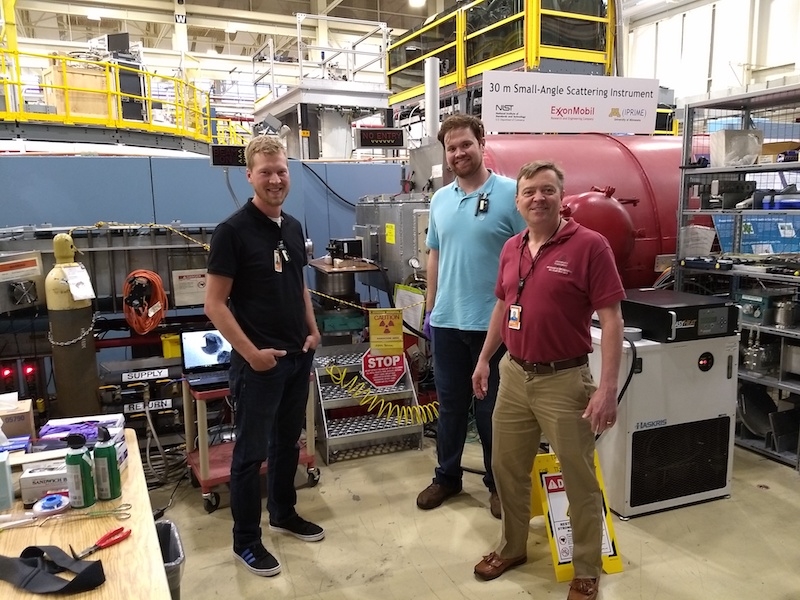
A mechanical engineering professor and his doctoral student drove 18 hours in one day for a chance to use a highly specialized piece of research equipment in Maryland, and the implications of their research could have a big impact on how cancer is treated.
David Huitink, assistant professor of mechanical engineering, and doctoral student Hayden Carlton undertook the journey to collaborate with researchers at the U.S. Department of Commerce's National Institute of Standards and Technology.
The pair traveled to the institute's Center for Neutron Research in Gaithersburg, Maryland to conduct neutron scattering experiments on the NG7-SANS beamline, a 30-meter long device used to detect material and nanoparticle interactions using a directed stream of neutrons, which pass through the material and observe its behaviors and characteristics.
The pair's research focuses on induction heating in nanoparticles. Induction heating refers to the heating of a material by an electric current within it when responding to electromagnetic fields, and Huitink said the practice has implications for cancer treatment research using nanoparticle heaters.
"This phenomenon is a potential path toward cancer hyperthermia treatments, where nanoparticles targeted to attach on to tumor tissue are heated up under influence of an external fields, leading to tissue necrosis — burning the cancer to death, basically," Huitink said. "The science is fascinating, but not well understood."
Using a technique known as Small Angle Neutron Scattering, Huitink and Carlton used the NG7-SANS beam to look at how particles move and arrange themselves under an induction field, as well as studying the magnetic behavior of the particles themselves. Both sets of information will help researchers design nanoparticles for optimal heating, which could make cancer treatments more effective, Huitink said.
The experiment led to even more opportunities for Carlton.
Carlton applied and was awarded the opportunity to spend another week at National Institute of Standards and Technology in June for "Neutron Summer School," where institute scientists teach basic principles, tools and applications in neutron science, something Carlton said has long been a focus of his interest.
"Nanoparticle research as a whole has always peaked my interest, even as an undergraduate," he said. "It's fascinating to me how these tiny particles release so much energy, and how far the breadth of their application goes. It's important to me to further advance nanoparticle induction heating research to not only find the limits of their therapeutic properties, but also to change their role in medical treatment for the better."
Carlton praised Huitink for playing a key role in his success as a researcher.
"I was one of Dr. Huitink's first graduate student hires," Carlton said. "I came from a background with little undergraduate research experience, and Dr. Huitink has helped me along every step of the way with guidance and strong technical knowledge that has made my transition to graduate school seamless. He always offers advice on structuring my graduate curriculum to prepare me for the job I want after graduate school, and he's just an all-around great guy to work for. I couldn't ask for a better graduate advisor."
Huitink said the trip came about after a conversation with U of A mechanical engineering alumni Tom Newton, who now directs the Center for Neutron Research for the National Institute of Standards and Technology.
Neutron scientists Kathryn Krycka and Markus Bleuel at the center were instrumental in executing the experiment, and Carlton said he left the project inspired.
"Going to NCNR has further influenced my desire to stay in research and potentially work in a national lab after completing the doctoral program here at the U of A," Carlton said. "While observing the dynamic of the scientists there, I saw people who enjoyed and took pride in the work that they did. In addition to attending the NCNR summer school in June, I'm planning to look for further opportunities to perform research in other national labs."
Topics
Contacts
David Huitink, assistant professor
Mechanical Engineering
479-575-6263, dhuitin@uark.edu
Nick DeMoss, director of communications
College of Engineering
479-575-5697, ndemoss@uark.edu